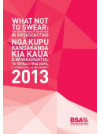Warning!
The report – and this page – contain language that some people will find offensive.
This report documents the findings of a national survey carried out in March 2013 among 1,500 members of the general public aged 18 years and over.
The survey measured how acceptable the public finds the use of swearwords, blasphemies and other expletives in broadcasting. This survey was first conducted in 1999 and repeated in 2005 and 2009.
Where possible, comparisons have been made with previous surveys to help determine whether public attitudes are changing over time.
Purpose
Quantitative research to provide a monitor of the acceptability of the use of swear words, blasphemies and other expletives in broadcasting over time
Methodology
- Administered national survey with 1,500 randomly selected individuals aged 18 years and over, stratified by region, age group, gender and ethnicity
- Online methodology survey was the same approach as used in 2010. This is differentiated from the 1999 and 2005 surveys which made use of a face-to-face interview technique
Key Results
31 words were presented to respondents, all of which are included in the 2010 survey
- Respondents rated eight words as Totally or Fairly unacceptable in relation to the scenario of a television drama shown after 8.30pm: Cunt (70%), Nigger (65%), Mother fucker (61%), Jesus Fucking Christ (61%), Cocksucker (56%), Get fucked (54%), Fuck off (50%) and Fuck (50%)
- The least contentious words, rated as Totally or Fairly acceptable, were: Bloody (15%), Bollocks (13%) and Bugger (13%)
- The order of the words found to be the most offensive to the least offensive remains largely the same as found in 2010 and in 2005
- There is a slight softening for some of the most offensive words with percentages of acceptability moving 1–5 percentage points but they remain high
- At the other end of the scale, there has been a slight decline in the acceptability of less offensive words like Bloody and Bugger
- When comparing the different demographic groups, it is evident that
- Males tend to be more accepting of the words than females
- Younger respondents tend to be more accepting than older respondents
- Those that state they have no religion tend to be more accepting than those of religious belief
- Those of Māori ethnicity are generally more accepting than those of other ethnicities, while Pacific peoples are less accepting
- Those on high household incomes tend to be more accepting
- Respondents were also asked to consider the acceptability of words in 10 different contexts. Some notable patterns that emerged were:
- Use of ‘bad’ language by radio hosts, in both breakfast programmes and talkback scenarios, is less acceptable than in other scenarios
- There appears less tolerance for use of ‘bad’ language from real people (as opposed to actors), including interviewees and callers to radio talkback
- ‘Bad’ language tends to be more acceptable when used after 8:30pm in the context of stand-up comedy and dramas than before 8:30pm
- ‘Bad’ language tends to be less acceptable in music videos on TV
- The majority (65%) hold the same views in relation to acceptability of language, irrespective of whether a broadcast is free-to-air or pay-to-view

